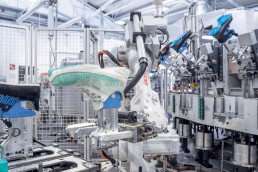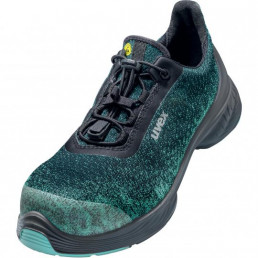In keeping with our motto “protecting people”, our products protect people’s health at work. We have also always taken the carbon footprint of uvex PPE seriously – because the health of the planet is very important to us, too. Therefore, we would now like to draw your attention to our ecologically sustainable products with our “protecting planet” label. In short, our product development and production are built on the following three pillars of sustainability: ecology, economics and social responsibility. In this blog post, discover the uvex 1 G2 planet safety shoe from the uvex planet series and create an exemplary carbon footprint in the process.
The three uvex pillars of sustainability: ecology, economics and social responsibility
Ecology – Ecology describes the interrelationship between the environment and humans. The focus is on ensuring that the natural environment – the climate, plants, animals, air and soil – is not disturbed or negatively affected by mankind.
With this in mind, we pay particular attention to ensuring that both the production processes and the product itself are ecologically sound and do not harm the environment. Since 2010, we have placed great importance on the sustainability of our safety shoes. With the introduction of the uvex banned hazardous substances list with over 167 hazardous substances, our focus shifted to environmentally friendly, healthy materials and substances. For example, by 2018 we had switched exclusively to the use of water-based separating agents, which are considered very environmentally friendly and flame retardant. This has allowed us to completely avoid the use of chemical substances that are harmful to both employees and the environment. We also focus on sustainability when it comes to our energy supply: in 2011, we installed the first photovoltaic systems at our safety shoe plant uvex Cagi in Ceva, Italy. These energy sources provide a total of 20% of the renewable energy in Germany. In 2018, we switched to green electricity – since 2019, the energy used at uvex Cagi has been 100% green. In the same year, we also switched to using biogas for our production facility. Since switching to renewable energy, we have been able to reduce our CO2 emissions per pair of safety shoes by 90%.
Green electricity and biogas are environmentally friendly sources of energy. Most green electricity is produced by hydroelectric power plants, wind turbines and solar panels. These methods of generating energy are particularly environmentally friendly and sustainable. Biogas is also known as green gas or renewable gas. This is based on conventional natural gas, which is a climate-friendly variant compared to fossil fuels. This is because when natural gas is burned, only half the CO2 is emitted as when coal is burned. There is therefore no difference between biogas and normal natural gas – however, the CO2 emissions of biogas produced during combustion are 100% offset by climate protection projects. This means that by saving greenhouse gases that are harmful to the climate all over the world, CO2 emissions are reduced many times over – since climate works globally, this cycle works all over the world.
Unfortunately, far too few people currently use green electricity – whether privately or commercially. In 2019, 12.67 million people in Germany were using green electricity, while 57.93 million people were still relying on environmentally damaging electricity. This means that just 22% of all households in Germany use green electricity. However, the figures for gross electricity consumption from renewable energy sources have been rising steadily since 1990 – in 2020, 45.4% of energy used in Germany was renewable.

Another important point is the issue of waste prevention. In 2013, we launched our first waste reduction project, reducing PU waste by changing the moulds. Rigid polyurethane foam (PU) contains no toxic substances and is therefore an environmentally friendly material suitable for use in safety footwear. By adapting the shapes of our soles for uvex safety shoes, we were able to effectively save waste. Since 2022, we have also been recycling the resulting surplus in our uvex 1 G2 planets midsole. 20% of the i-PUREnrj midsole consists of recycled PU granulate from our own production. By switching raw material deliveries from IBC containers to tankers, we were able to reduce further waste from 2019. Intermediate bulk containers (IBCs) are usually made of plastic and/or metal – this method of transport is considered very robust. Although most IBCs can be recycled, only 30% of all plastic waste in Germany is recycled. The remaining 70% has to be incinerated or ends up as plastic waste in the sea. Therefore, switching to tank trucks is far more environmentally friendly. Because in this case, the liquid substances are stored and transported directly in the truck – additional transport containers that produce waste are therefore not needed.
Having already avoided the use of harmful substances for many years, our next big focus was on the use of recyclable materials. And in 2020, we succeeded in manufacturing our first uvex safety shoes from recycled components, launching them on the market in 2021. More than 80% of uvex safety shoes now contain at least one recycled component. You’ll find more information about sustainable work clothing on our blog.
“For over 90 years, we have been producing and selling high-quality products to protect people in sports, leisure and at work. Any company wanting to protect people must accept the responsibility that comes with it. It is exactly this mission that instils our commitment to work sustainably, and in an ethically and socially responsible manner.”
Michael Winter, Managing Partner of the uvex group
Economics – Economics describes the economic efficiency between machines and people or facilities. Of course, uvex also adheres to the economic principle by using our raw materials as efficiently as possible.
By considering each of our actions ecologically, economically and socially to ensure that they are all in perfect harmony, we were able to obtain ISO 14001 environmental management system certification in 2017. Thanks to our continuous improvement in environmental awareness and waste reduction as well as in sustainable management, we are particularly pleased about our ISO 14001 certification, in addition to several others.
Carbon footprint of the uvex 1 G2 planet safety shoe
The carbon footprint of a product refers to the total amount of the CO2 emissions that are generated by production of the product. It also includes the CO2 emissions that are emitted during use and disposal. Every year, a person creates an average carbon footprint of 11 tonnes. This value can be broken down as follows:
- 9% public emissions (e.g. hospitals, roads, etc.)
- 25% housing/energy consumption
- 30% consumption (e.g. safety clothing, electrical equipment, hotels, etc.)
- 13% eating & drinking
- 23% mobility
Unfortunately, we as individuals cannot influence the level of public emissions – but we can do something about the remaining points. Do you have any idea how high your personal carbon footprint is? Find out now by clicking on the button below.
To help you reduce your carbon footprint, we have made it our mission to produce our uvex products in the most environmentally friendly way possible. For the first time ever, we’ve calculated the CO2 footprint for a uvex safety shoe. And it was easy, thanks to SimaPro 9.2.0.1 software and the ecoinvent database 3.6. This is because the software has several data libraries, among them the ecoinvent database, which contains data on international supply variants, raw material extraction, agriculture, transport and much more. We were therefore able to calculate a carbon footprint of 8.5 kg for the regular uvex 1 G2 safety shoe with knitted shaft (model 68342). The emissions of the raw materials up to the point of first use were taken into account. We performed the same calculation on the new uvex 1 G2 planet, whose carbon footprint is 6.9 kg – a value roughly equivalent to a car journey of 35 kilometres. By using environmentally friendly and recyclable materials, we were able to reduce CO2 emissions by 18.8%.
The uvex 1 G2 planet safety shoe – ecologically sustainable
With the uvex 1 G2 planet, the previous uvex 1 G2 has now been developed to be even more environmentally friendly and ecologically sustainable – in keeping with the motto “protecting planet”. Particular emphasis was placed on the following points:

Bio-based and recyclable material – without pollutants
The “uvex x-dry knit planet” outer shoe material on the uvex 1 G2 planet safety shoe is made of 100% recycled polyester, from PET bottles, as is the penetration resistance and 52% of the distance mesh lining. More information about recycled polyester can be found on our blog.
We also use recycled polyurethane from our own production. Polyurethane is the main component of our soles and a durable plastic. Production-related residues are generated during the manufacture of our footwear, which we collect, shred and mix back into our soles in the form of granules. 20% of the uvex i-PUREnrj midsole consists of granulate crumbs without sacrificing performance. In addition, the recycled PU surplus is also found in the uvex x-tendet grip planet outsole – which consists of 10% polyurethane granules. In addition to recycled polyester and polyurethane , recycled TPU is also used. Thermoplastic polyurethane is an extremely flexible, durable synthetic plastic. The TPR overcap of the uvex 1 G2 planet is made of 40% recycled material. The comfortable climatic insole is made of 100% recycled polyester and PU foam. The recycled PU waste is used in turn in the uvex x-tended grip planet outsole – this consists of 10% polyurethane waste. The remaining 18% of the distance mesh lining is made from bamboo fibres – find out more about the advantages of bamboo fibre on our blog. Of course, all toxic substances that are included in the uvex hazardous substances list are no longer used. Even with innovations in sustainability guidelines, we always adapt our processes and material selection to ensure that our products continue to be produced in an environmentally conscious manner.
Environmentally friendly packaging
Our uvex 1 G2 planet safety shoes are delivered to you in environmentally friendly packaging. The shoe boxes are made of 90% recycled cardboard and the instructions for use are made of 100% recycled tissue paper. Recycled paper is made from waste paper, cardboard or cartons, with no need to use wood. That’s why recycled paper and tissue paper are considered particularly environmentally friendly. We use recycled paper throughout the company.
How environmentally friendly is your company? Have you already calculated your personal carbon footprint? If your CO2 emissions have got you thinking, change your life and your business today! We’re happy to help provide you with our environmentally friendly and recyclable safety products.
Sources:
https://de.statista.com/themen/566/oekostrom/
https://www.sauberenergie.de/klimaschutz/was-ist-%C3%B6koenergie
https://de.statista.com/statistik/daten/studie/173871/umfrage/stromerzeugung-aus-erneuerbaren-energien-in-deutschland/
https://klima-kollekte.de/fileadmin/user_upload/Persoenlicher_CO2-Fussabdruck.pdf
